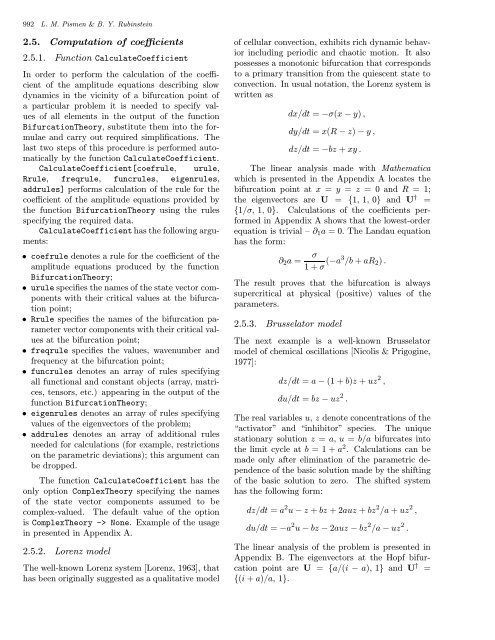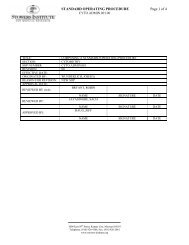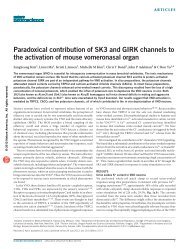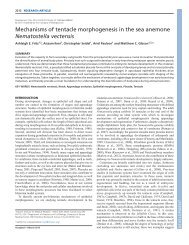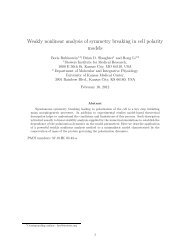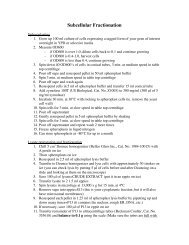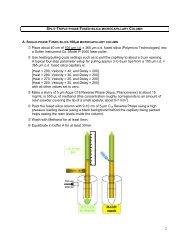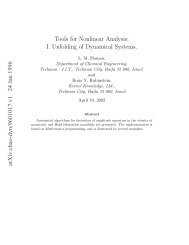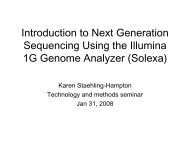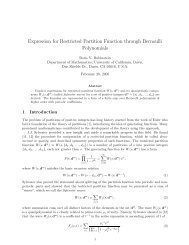Computer Tools for Bifurcation Analysis: General Approach with
Computer Tools for Bifurcation Analysis: General Approach with
Computer Tools for Bifurcation Analysis: General Approach with
Create successful ePaper yourself
Turn your PDF publications into a flip-book with our unique Google optimized e-Paper software.
992 L. M. Pismen & B. Y. Rubinstein<br />
2.5. Computation of coefficients<br />
2.5.1. Function CalculateCoefficient<br />
In order to per<strong>for</strong>m the calculation of the coefficient<br />
of the amplitude equations describing slow<br />
dynamics in the vicinity of a bifurcation point of<br />
a particular problem it is needed to specify values<br />
of all elements in the output of the function<br />
<strong>Bifurcation</strong>Theory, substitute them into the <strong>for</strong>mulae<br />
and carry out required simplifications. The<br />
last two steps of this procedure is per<strong>for</strong>med automatically<br />
by the function CalculateCoefficient.<br />
CalculateCoefficient[coefrule, urule,<br />
Rrule, freqrule, funcrules, eigenrules,<br />
addrules] per<strong>for</strong>ms calculation of the rule <strong>for</strong> the<br />
coefficient of the amplitude equations provided by<br />
the function <strong>Bifurcation</strong>Theory using the rules<br />
specifying the required data.<br />
CalculateCoefficient has the following arguments:<br />
• coefrule denotes a rule <strong>for</strong> the coefficient of the<br />
amplitude equations produced by the function<br />
<strong>Bifurcation</strong>Theory;<br />
• urule specifies the names of the state vector components<br />
<strong>with</strong> their critical values at the bifurcation<br />
point;<br />
• Rrule specifies the names of the bifurcation parameter<br />
vector components <strong>with</strong> their critical values<br />
at the bifurcation point;<br />
• freqrule specifies the values, wavenumber and<br />
frequency at the bifurcation point;<br />
• funcrules denotes an array of rules specifying<br />
all functional and constant objects (array, matrices,<br />
tensors, etc.) appearing in the output of the<br />
function <strong>Bifurcation</strong>Theory;<br />
• eigenrules denotes an array of rules specifying<br />
values of the eigenvectors of the problem;<br />
• addrules denotes an array of additional rules<br />
needed <strong>for</strong> calculations (<strong>for</strong> example, restrictions<br />
on the parametric deviations); this argument can<br />
be dropped.<br />
The function CalculateCoefficient has the<br />
only option ComplexTheory specifying the names<br />
of the state vector components assumed to be<br />
complex-valued. The default value of the option<br />
is ComplexTheory -> None. Example of the usage<br />
in presented in Appendix A.<br />
2.5.2. Lorenz model<br />
The well-known Lorenz system [Lorenz, 1963], that<br />
has been originally suggested as a qualitative model<br />
of cellular convection, exhibits rich dynamic behavior<br />
including periodic and chaotic motion. It also<br />
possesses a monotonic bifurcation that corresponds<br />
to a primary transition from the quiescent state to<br />
convection. In usual notation, the Lorenz system is<br />
written as<br />
dx/dt = −σ(x − y) ,<br />
dy/dt = x(R − z) − y,<br />
dz/dt = −bz + xy .<br />
The linear analysis made <strong>with</strong> Mathematica<br />
which is presented in the Appendix A locates the<br />
bifurcation point at x = y = z =0andR=1;<br />
the eigenvectors are U = {1, 1, 0} and U † =<br />
{1/σ, 1, 0}. Calculations of the coefficients per<strong>for</strong>med<br />
in Appendix A shows that the lowest-order<br />
equation is trivial – ∂ 1 a =0.The Landau equation<br />
has the <strong>for</strong>m:<br />
∂ 2 a =<br />
σ<br />
1+σ (−a3 /b + aR 2 ) .<br />
The result proves that the bifurcation is always<br />
supercritical at physical (positive) values of the<br />
parameters.<br />
2.5.3. Brusselator model<br />
The next example is a well-known Brusselator<br />
model of chemical oscillations [Nicolis & Prigogine,<br />
1977]:<br />
dz/dt = a − (1 + b)z + uz 2 ,<br />
du/dt = bz − uz 2 .<br />
The real variables u, z denote concentrations of the<br />
“activator” and “inhibitor” species. The unique<br />
stationary solution z = a, u = b/a bifurcates into<br />
the limit cycle at b =1+a 2 . Calculations can be<br />
made only after elimination of the parametric dependence<br />
of the basic solution made by the shifting<br />
of the basic solution to zero. The shifted system<br />
has the following <strong>for</strong>m:<br />
dz/dt = a 2 u − z + bz +2auz + bz 2 /a + uz 2 ,<br />
du/dt = −a 2 u − bz − 2auz − bz 2 /a − uz 2 .<br />
The linear analysis of the problem is presented in<br />
Appendix B. The eigenvectors at the Hopf bifurcation<br />
point are U = {a/(i − a), 1} and U † =<br />
{(i + a)/a, 1}.


